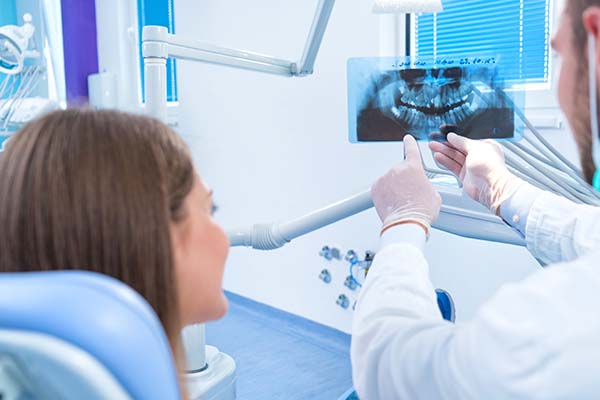PERIODONTAL DISEASECarpinteria, CA
The word periodontal means “around the tooth”. Periodontal disease attacks the gums and the bone that support the teeth. Plaque is a sticky film of food debris, bacteria, and saliva. If plaque is not removed, it turns into calculus (tartar). When plaque and calculus are not removed, they begin to destroy the gums and bone. Periodontal disease is characterized by red, swollen, and bleeding gums.
Four out of five people have periodontal disease and don’t know it! Most people are not aware of it because the disease is usually painless in the early stages.
Not only is it the number one reason for tooth loss, research suggests that there may be a link between periodontal disease and other diseases such as, stroke, bacterial pneumonia, diabetes, cardiovascular disease, and increased risk during pregnancy. Researchers are determining if inflammation and bacteria associated with periodontal disease affects these systemic diseases and conditions. Smoking also increases the risk of periodontal disease.
Good oral hygiene, a balanced diet, and regular dental visits can help reduce your risk of developing periodontal disease.
Signs and symptoms of periodontal disease:
- Bleeding gums – Gums should never bleed, even when you brush vigorously or use dental floss.
- Loose teeth – Also caused by bone loss or weakened periodontal fibers (fibers that support the tooth to the bone).
- New spacing between teeth – Caused by bone loss.
- Persistent bad breath – Caused by bacteria in the mouth.
- Pus around the teeth and gums – Sign that there is an infection present.
- Receding gums – Loss of gum around a tooth.
- Red and puffy gums – Gums should never be red or swollen.
- Tenderness or Discomfort – Plaque, calculus, and bacteria irritate the gums and teeth.
CAUSES OF PERIODONTAL DISEASE
Periodontal (gum) disease, which is also known as periodontal disease and periodontitis, is a progressive disease which if left untreated may result in tooth loss. Gum disease begins with the inflammation and irritation of the gingival tissues which surround and support the teeth. The cause of this inflammation is the toxins found in plaque which cause an ongoing bacterial infection.
The bacterial infection colonizes in the gingival tissue and deep pockets form between the teeth and the gums. If treated promptly by a periodontist, the effects of mild inflammation (known as gingivitis) are completely reversible. However, if the bacterial infection is allowed to progress, periodontal disease begins to destroy the gums and the underlying jawbone; promoting tooth loss. In some cases, the bacteria from this infection can travel to other areas of the body via the bloodstream.
Common Causes of Gum Disease
There are genetic and environmental factors involved in the onset of gum disease, and in many cases the risk of developing periodontitis can be significantly lowered by taking preventative measures.
Here are some of the most common causes of gum disease:
- Poor dental hygiene – Preventing dental disease starts at home with good oral hygiene and a balanced diet. Prevention also includes regular dental visits which include exams, cleanings, and x-rays. A combination of excellent home care and professional dental care will ensure and preserve the natural dentition and supporting bony structures. When bacteria and calculus (tartar) are not removed, the gums and bone around the teeth become affected by bacteria toxins and can cause gingivitis or periodontitis, which can lead to tooth loss.
- Tobacco use – Research has indicated that smoking and tobacco use is one of the most significant factors in the development and progression of gum disease. In addition to smokers experiencing a slower recovery and healing rate, smokers are far more likely to suffer from calculus (tartar) build up on teeth, deep pockets in the gingival tissue and significant bone loss.
- Genetic predisposition – Despite practicing rigorous oral hygiene routines, as much as 30% of the population may have a strong genetic predisposition to gum disease. These individuals are six times more likely to develop periodontal disease than individuals with no genetic predisposition. Genetic tests can be used to determine susceptibility and early intervention can be performed to keep the oral cavity healthy.
- Pregnancy and menopause – During pregnancy, regular brushing and flossing is critical. Hormonal changes experienced by the body can cause the gum tissue to become more sensitive, rendering them more susceptible to gum disease.
- Chronic stress and poor diet – Stress lowers the ability of the immune system to fight off disease, which means bacterial infections may possibly beat the body’s defense system. Poor diet or malnutrition can also lower the body’s ability to fight periodontal infections, as well as negatively affecting the health of the gums.
- Diabetes and underlying medical issues – Many medical conditions can intensify or accelerate the onset and progression of gum disease including respiratory disease, heart disease, arthritis and osteoporosis. Diabetes hinders the body’s ability to utilize insulin which makes the bacterial infection in the gums more difficult to control and cure.
- Grinding teeth – The clenching or grinding of the teeth can significantly damage the supporting tissue surrounding the teeth. Grinding one’s teeth is usually associated with a “bad bite” or the misalignment of the teeth. When an individual is suffering from gum disease, the additional destruction of gingival tissue due to grinding can accelerate the progression of the disease.
- Medication – Many drugs including oral contraceptive pills, heart medicines, anti-depressants and steroids affect the overall condition of teeth and gums; making them more susceptible to gum disease. Steroid use promotes gingival overgrowth, which makes swelling more commonplace and allows bacteria to colonize more readily in the gum tissue.
Treatment of Gum Disease
Periodontists specialize in the treatment of gum disease and the placement of dental implants. A periodontist can perform effective cleaning procedures in deep pockets such as scaling and root planing, and also prescribe antibiotic and antifungal medications to treat infection and halt the progression of the disease.
In the case of tooth loss, the periodontist is able to perform tissue grafts to promote natural tissue regeneration, and insert dental implants if a tooth or several teeth are missing. Where gum recession causes a “toothy” looking smile, the periodontist can recontour the gingival tissue to create an even and aesthetically pleasing appearance.
Preventing periodontal disease is critical in preserving the natural dentition. Addressing the causes of gum disease and discussing them with your dentist will help prevent the onset, progression, and recurrence of periodontal disease.





